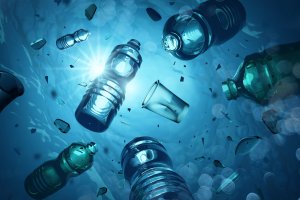Posted on 27th February 2020 by Hintons
Microplastics, despite being less than a few centimetres in size, are clogging up our ecosystems. This, together with the build up of larger plastic debris, can have an incredibly harmful impact on the environment. But what are microplastics and how can we limit our use of them?
What Are Microplastics?
According to the National Ocean Service (NOAA), microplastics are “small plastic pieces less than five millimetres long which can be harmful to our ocean and aquatic life”. Unfortunately, plastic is the most common type of marine debris, coming in all shapes and sizes, even those which are less than 5mm long.
Microplastics can be found in toiletries, and even shed from our clothes while they’re being washed. Despite being ‘micro’, their effects on the environment are just as damaging as larger pieces of plastic debris floating in our oceans, particularly when there’s a considerable build-up of microplastics. All plastic – regardless of the shape or size – will take around 450 years to decompose.
Microplastics are classified into two separate groups – primary and secondary:
Primary microplastics – these pieces of plastic were already 5mm or less when they entered our oceans. Clothing fibres, microbeads and plastic pellets are considered to be examples of primary microplastics.
Secondary microplastics – these plastic fragments were created through the process of degradation. This is when larger pieces of plastic are broken down over a considerable period of time and therefore release microplastics into the ecosystem.
Where Do Microplastics Come From?
Where some microplastics can be found in body exfoliants and materials such as fleece, others come about through the process of degradation.
Degradation – a chemical process which leads to the breaking down of polymers. The integrity of the plastic depends on molecular weight, however, degradation will eventually weaken the plastic, causing it to eventually break away from the main body. Often, these pieces are invisible to the human eye and are therefore considered to be microplastics.
Despite this, these tiny pieces of plastic will still undergo further degradation. The carbon (found in the polymer) will then be modified to become carbon dioxide, which will eventually find its way into the marine biomass.
Sources of microplastics:
- Manufacturing
- Packaging and shipping
- Sewage treatment plants
- Fishing industry
- Vehicle tyres
- Water bottles
- Clothes
- Cosmetics
Why Are Microplastics Harmful To The Environment?
Due to the size and scale of microplastics, they often find their way into natural ecosystems, having detrimental effects. A scientific review published by the European Union’s Scientific Advice Mechanism stated that microplastics can now be found in every part of the environment.
Problems caused by microplastics being present in ecosystems:
- Threatening to marine life
- Animals can ingest, suffocate or entangle themselves in plastic. Often, this results in death or a debilitating injury
- Contamination of food consumed by humans
- Can lead to the transfer of persistent organic pollutants (POPs)
- Microplastics can transport POPs from the environment to other organisms
How can we reduce our use of microplastics?
In order to minimise the amount of microplastics which end up in the ecosystem, we must change our habits and take action to prevent more microplastics being released into the environment.
The ways we can limit our use of microplastics:
- Refrain from buying bottled water – buy a water filter and a reusable bottle instead
- Buy eco-friendly garments, such as ocean-friendly swimwear and all-cotton bedding which promises that zero waste will be produced
- Don’t use your tumble dryer – leave clothes to air dry
- Reduce the amount of meat and fish you eat – this limits the amount of plastic you’re unintentionally consuming
- Buy a laundry ball – this will catch microplastics from your clothes while they’re being washed, thus preventing microplastics from entering the water system
- Don’t buy toiletries or cosmetics that contain microplastics – instead, use exfoliating gloves or buy products which contain natural exfoliants, such as sugar, oats or rice (always read the label)
- Take public transport where possible – this will limit the number of cars on the road. Fewer cars will result in a reduced amount of microplastics being produced
Did you know?
- Samples collected from nearly 30 Great Lakes throughout the USA contained plastic fragments – 98% of these were microplastics, varying from 0.355mm-4.75mm
- A study carried out in New York City, USA, found that all 18 sampled and tested fish species had some level of plastic present in their system
- Almost every water system in the world contains microplastics
- 80% of plastic debris found in the ocean originates on land
- Signs of plastic contamination were found in 93% of all bottled water
- Every year, one million tonnes of plastic fibre are released into wastewater systems
- Car tyres shed approximately 20g of microplastic dust for every 100km the vehicle travels.
- Microplastics can contaminate the entire food chain, including fish products which are subsequently eaten by humans
- Synthetic clothes shed microplastics in the washing machine, eventually finding their way into the water system
- Around 114 fragments of microplastic land on a dinner plate within 20 minutes. This equates to between 13,000 and 68,000 pieces of plastic every year
- We could be inhaling microplastic every time we breathe in
Hinton’s Waste is a leading waste management company who are dedicated to the safe and responsible disposal of the waste material we collect. We’re entirely committed to maintaining our environmentally-friendly services and practices, ensuring nothing is sent to landfill. With our specialist recycling facilities located throughout Croydon, Sutton and London, you can rest assured that your waste will be disposed of sustainably. For more information about the services we offer, including skip hire, grab hire and waste and junk clearance, get in touch with us either online or by phone.

